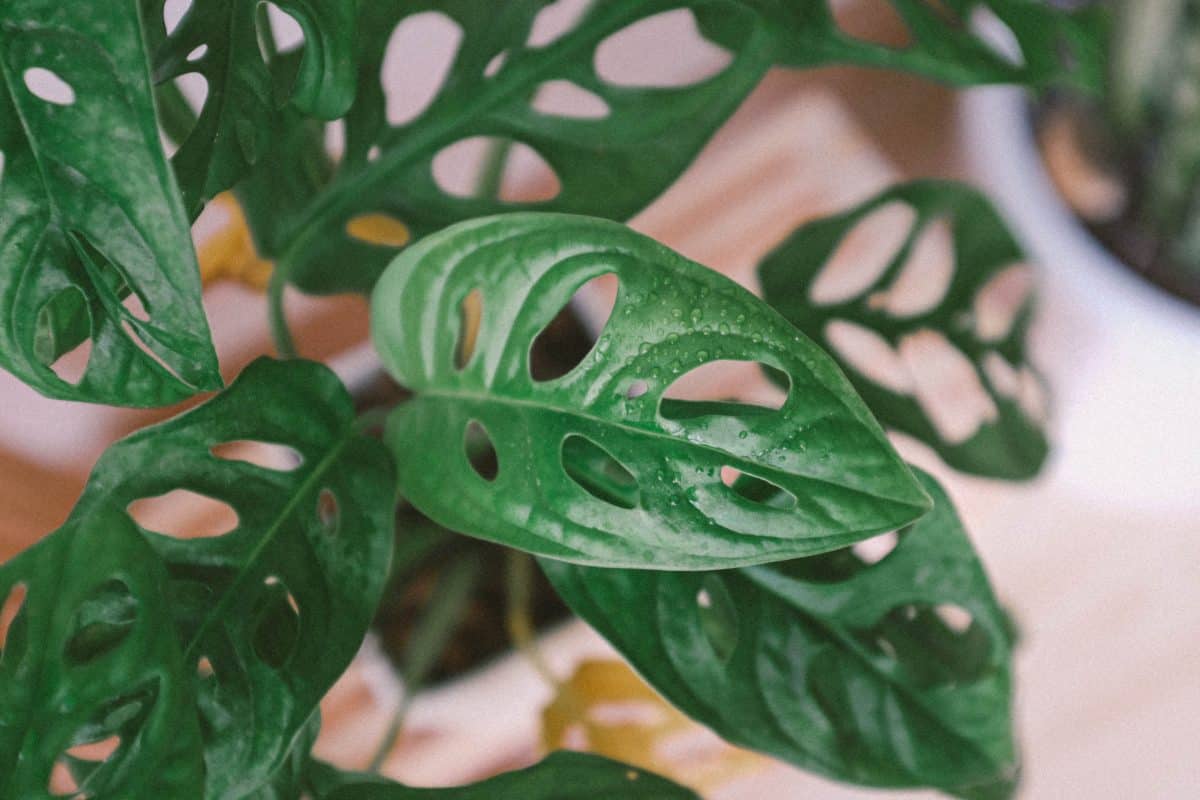The indoor houseplant world has fallen head over heels for the beautiful monstera plant and its large slotted leaves. With our ultimate guide to monstera varieties, you’ll have no problem selecting the perfect one to complement your indoor or outdoor garden.
Table of Contents
A Brief History of Monstera Plants
The Monstera plant is native to the tropical rainforests of Central and South America, specifically in Mexico, Panama, and Colombia. Its scientific name is Monstera deliciosa, which translates to “delicious monster” due to its ability to produce edible fruit when fully ripened.
There are 48 known monstera varieties, with the most popular being the Monstera deliciosa and Monstera adansonii. These two varieties have distinct differences in their appearance, making them easy to identify and differentiate.
The plant’s popularity is mainly thanks to its easy-to-grow nature, making it a perfect choice for beginner and experienced gardeners. Monstera plants can thrive in various light conditions, from bright and indirect to low light, making them adaptable to indoor environments.
These plants are often confused with philodendrons but are not the same. You can learn more about spotting the difference between the two so that the plant you choose is the one you really want.
The Ultimate Guide To Monstera Varieties: Top 9 Species
Monstera Deliciosa
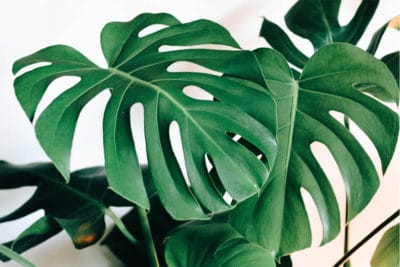
This is the most common of monstera varieties we all know and love, and mostly what you’ll find when you go plant shopping. It has those big, gorgeous holey leaves that are popular in nurseries and printed home decor. Whether a beginner or an experienced gardener, the Monstera Deliciosa is a must-have for any home grower. (Click here for The Ultimate Guide to Monstera Leaf Care.)
Fun fact: This plant is called “deliciosa” because it produces Mexican breadfruit.
Monstera Borsigniana
This is a variation of deliciosa and might sell under the same name because it’s hard to distinguish between them when they’re young.
One way to tell is to look at the stem. Deliciosas tend to ruffle, pucker, or form cute little bumps where the leaf attaches to the stem, but borsigniana does not. Borsigiana is also smaller and grows faster than deliciosa. Mature plants usually form two neat rows of holes/slits instead of growing holes in a more willy-nilly style like deliciosa.
If you end up with one of these instead of a deliciosa, never fear! It can grow just as tall, almost as big, and a bit faster, and it’s still a stunning addition to your home. It is one of the more unique monstera varieties.
Monstera Variegata
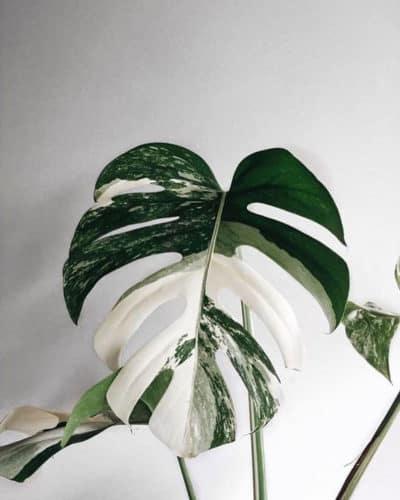
Variegated monsteras aren’t separate plants but rather a color variation. Sometimes, these plants even look like they are coated with white paint, a feature I have come to love in my own indoor Monstera garden.
Variegated means plants that are patterned with white or cream color as well as green. Therefore, these plants tend to be harder to find and are much more expensive. Many monstera varieties come in this variegated form, but not all are easy to hunt down. Check out where to find a variegated monstera here.
Monstera Adansonii
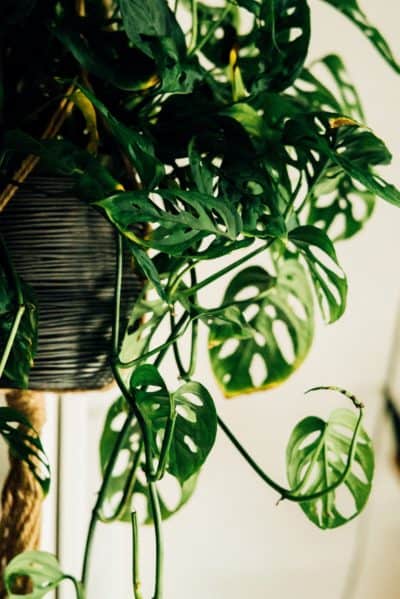
These monstera varieties are a bit smaller than the deliciosa, but the holes are still quite large, taking up about 50% of the leaf. These are relatively easy to find, but they’re also mislabeled as monstera obliqua (but true obliqua are extremely rare, so you can be assured that if you see this label in a nursery, you’re actually looking at a monstera adansonii). Adansonii also tend to have thicker, rougher leaves than obliqua.
Monstera Pinnatipartita
These guys have very large, glossy leaves but tend to grow slits, rather than holes, that go to the edge of the leaf. The leaf stems are stiff and sturdy, and they have a gorgeous emerald-green color.
Like many options on our ultimate guide to monstera varieties, this rare specimen can be hard to track down at a local nursery. However, with some patience and persistence, you can add this beauty to your plant collection through propagation or purchasing from a specialized plant store.
Watch how to propagate any monstera plant in just 5 minutes!
Monstera Dubia

This is one of my favorite monstera varieties! This variety is characterized by very small, heart-shaped leaves with both dark and light green coloration. It’s not variegated per se, but approaching it. It grows like a vine with shorter stems and leaves that grow closer to whatever the plant is climbing.
The Monstera Dubia is among the most prized varieties of the Monstera family, making it a rare and coveted addition to any plant collection. Its unique appearance and growth pattern make it perfect for hanging baskets or climbing a trellis.
Monstera Siltepecana
These lovely monstera varieties have large, teardrop-shaped leaves with smaller holes concentrated around the central vein. They’re often lighter in color than other monsteras and contain both dark and light green hues.
Maintaining the variegated Monstera Siltepecana can be tricky, as it requires high humidity and bright, indirect light to maintain its unique coloration. However, with proper care, premium Monstera soil, and the right houseplant accessories, you can enjoy the stunning beauty of this variety in your own home.
Monstera Obliqua

The unique look of the Monstera Obliqua makes it one of the most rare Monstera species on the planet.
One of the rarest specimens in our ultimate monstera varieties guide, the Obliqua is highly coveted by plant enthusiasts due to its delicate, lacy leaves and unique growth pattern. Instead of developing holes and slits as it grows, the obliqua produces fenestrations (thin windows in the leaves) that give it a delicate, almost paperlike appearance.
Only 17 have been spotted in the wild, and due to its rarity, the Monstera Obliqua is often sold at high prices through specialized plant stores or online auctions. However, if you are lucky enough to find one, it can make a stunning and rare addition to your Monstera collection.
Rhaphidophora Tetrasperma or “Mini Monstera”

You’d never know this wasn’t a Monstera plant!
We’re cheating here because this plant isn’t technically a monstera (you probably noticed “monstera” wasn’t in the scientific name), but they look beautiful when displayed with one!
This plant looks like a smaller version of Monstera with the same characteristic holes in the leaves, though the large holes tend to reach all the way to the edge of the leaf and appear more notched.
The deep green color is stunning, and these are more common than some of the more exotic monstera varieties and are still fairly easy to care for. With our Mini Monstera care tips, you can easily add this beautiful plant to your indoor Monstera garden.
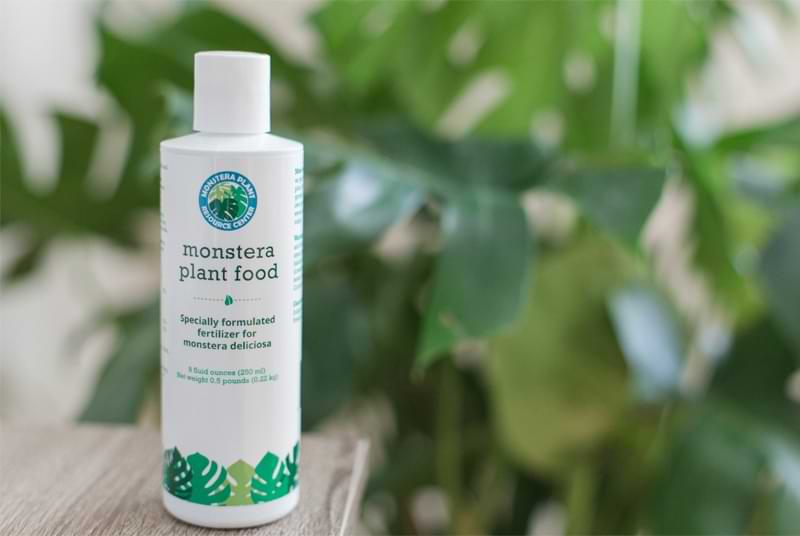
Give your Monstera everything it needs to thrive with a balanced indoor plant food containing essential nutrients that help plants grow strong and vibrant.
How To Care For A Monstera Plant
No matter the species, monsteras are tropical plants that love warm temperatures and high humidity. They do best in bright, indirect light but can tolerate some shade. Allow the top inch of soil to dry out before watering, and ensure proper drainage to prevent root rot.
Fertilizing every few weeks with monstera plant food during the growing season will also help your Monstera thrive. Keep an eye out for pests like spider mites and mealybugs, which can attack the leaves. If you spot them, use leaf shine wipes and leaf armor to keep them away during plant isolation.
If you want your Monstera to grow faster and produce larger leaves, try trimming the aerial roots with sharp pruning shears. The plant uses these roots to climb and absorb nutrients from their environment, but removing them will redirect energy towards leaf growth.
Get Yourself A Houseplant From The Ultimate Guide To Monstera Varieties
Whether a classic monstera deliciosa or an exotic obliqua, there’s a monstera species for every plant lover. Consider adding one of these stunning varieties to your collection and watch them grow into beautiful, unique plants. Happy growing!
Want exclusive growing tips and special offers on houseplant accessories? Subscribe to our newsletter and never miss a chance to level up your plant care game. Keep exploring our site for more helpful guides, information on the latest trends in indoor gardening, and premium Monstera plants and accessories to help you create the perfect green space in your home.
Monstera Plant Resource Center Additional Learning
- Sign up for our free Ultimate Monstera Webinar.
- Click to join our community on Facebook: Monstera Plant Resource Group.
- Read our Ultimate Monstera Watering Guide here.
- Looking to shop for plants online? Our trusted partners at Houseplantshop.com grow high-quality plants here in California and ship them directly to you. Shop online now!


